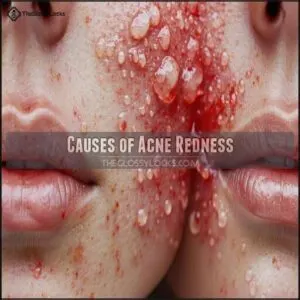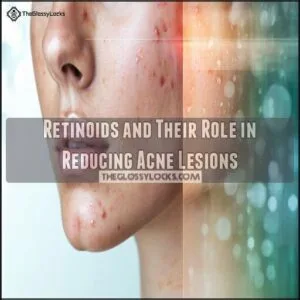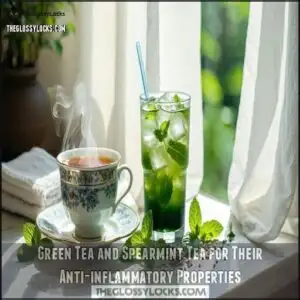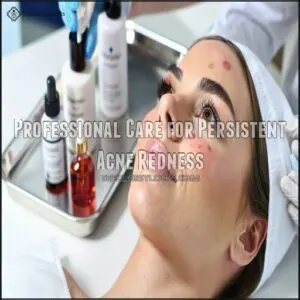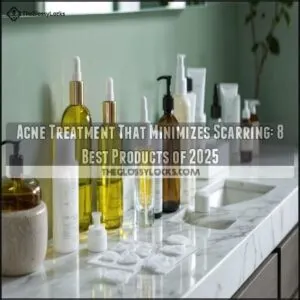This site is supported by our readers. We may earn a commission, at no cost to you, if you purchase through links.
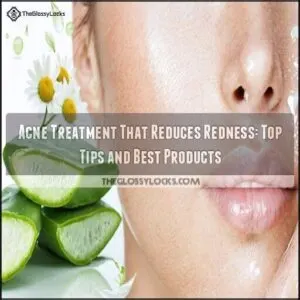
Look for products with salicylic acid or niacinamide—they’re like superheroes against redness, shrinking pores and easing irritation.
Applying a cold compress or ice pack (wrapped in a cloth!) can quickly reduce swelling.
Lightweight moisturizers, like CeraVe PM or Peach Slices Redness Relief Cream, can help hydrate without clogging your skin.
Avoid picking your skin—it’s tempting, but it makes redness worse, like adding fuel to a fire.
Consistency is key, so stick with your routine.
Wondering about natural remedies or advanced treatments? There’s more to explore ahead.
Table Of Contents
- Key Takeaways
- Causes of Acne Redness
- Effective Acne Treatments for Redness
- Top 8 Moisturizers for Acne-Prone Skin
- 1. La Roche-Posay Face Moisturizer Repair
- 2. Tata Harper Clarifying Oily Skin Moisturizer
- 3. First Aid Beauty Dewy Gel Cream
- 4. Codex Labs Shaant Balancing Face Cream
- 5. Avène Tolerance Control Balm Dry Skin
- 6. Cetaphil Acne Mattifying Moisturizer Salicylic Acid
- 7. Peach Slices Redness Relief Cream
- 8. CeraVe PM Facial Moisturizing Lotion
- Reducing Acne Redness Naturally
- Professional Care for Persistent Acne Redness
- Frequently Asked Questions (FAQs)
- How to reduce redness & inflammation from acne?
- What is the treatment for redness on the skin?
- How to reduce acne redness overnight?
- Can a dermatologist treat acne redness?
- What is the best way to treat redness?
- What is acne redness?
- How long does acne redness typically last?
- What ingredients calm acne-related irritation effectively?
- Does stress contribute to persistent acne redness?
- Are there over-the-counter redness-reducing spot treatments?
- Conclusion
Key Takeaways
- Use ingredients like salicylic acid and niacinamide to reduce redness and calm inflammation.
- Apply ice for quick relief by shrinking blood vessels and soothing irritated skin.
- Don’t pick at your skin; it worsens redness and delays healing.
- Stick to a consistent routine with lightweight, non-comedogenic moisturizers to hydrate without clogging pores and promote quick relief.
Causes of Acne Redness
Acne redness happens when your skin reacts to inflammation, clogged pores, or infections, leaving it irritated and sensitive.
Acne redness arises from inflammation or clogged pores, turning sensitive skin into an irritated battlefield.
From post-inflammatory marks to swollen blood vessels, understanding these causes helps you tackle redness more effectively.
Trauma to Skin Cells
Picking at pimples can cause trauma to skin cells, triggering acne redness and scarring mechanisms.
The healing process slows, leaving marks that stick around.
Focus on these prevention strategies:
- Stop picking to avoid cellular damage and calm acne redness.
- Apply soothing acne treatments with anti-inflammatory compounds.
- Use ice for acne redness relief and to ease inflammation instantly.
Post-inflammatory Hyperpigmentation (PIH)
Post-inflammatory hyperpigmentation (PIH) leaves behind stubborn marks after acne heals, turning red spots into dark discoloration.
PIH severity and duration depend on your skin type and healing process. Thankfully, you can minimize its impact with consistent care!
| Strategies for Acne Redness Relief | Descriptions |
|---|---|
| Avoid Sun Without Sunscreen | Reduces skin discoloration |
| Use Skin-Lightening Products | Fades hyperpigmentation |
| Opt for Brightening Ingredients | Targets PIH mechanisms |
| Stay Patient with Healing | Shortens PIH duration |
Inflammation and Dilation of Blood Vessels
Acne redness often worsens due to the vascular response, where blood vessels dilate during skin inflammation.
Blood vessels dilate during skin inflammation, keeping redness alive—calming this response is key to soothing irritated acne-prone skin.
This dilation, triggered by inflammatory mediators, keeps blemishes red and irritated longer.
Effective redness reduction focuses on calming these overactive responses.
Try anti-inflammatory compounds like niacinamide or ingredients that promote blood vessel shrinkage.
Proper acne inflammation treatment can help shorten the dilation duration, soothing your skin.
Infections Causing Red and Inflamed Blemishes
Bacterial infections can turn a small blemish into a fiery red spot.
Fungal acne, though mistaken for regular pimples, brings unique challenges, while viral involvement is rare but possible.
Infection severity determines scarring potential, making proper acne inflammation treatment essential.
Reduce skin inflammation with anti-inflammatory compounds and antimicrobial products to calm redness.
Don’t let untreated infections derail your skincare journey!
Effective Acne Treatments for Redness
You don’t have to live with the redness that acne leaves behind.
Effective treatments like retinoids and salicylic acid work to calm inflammation, reduce redness, and promote clearer skin over time.
Retinoids and Their Role in Reducing Acne Lesions
Retinoids work wonders for acne treatment, soothing redness with anti-inflammatory compounds.
They regulate skin tone, clear clogged pores, and prevent future breakouts.
Non-comedogenic cleansers are essential to prevent clogged pores and maintain hydration.
Here’s what makes them a redness acne solution:
- Tretinoin Benefits – Reduces discoloration.
- Adapalene Efficacy – Gentle, yet powerful.
- Combining Retinoids – Boosts results.
- Retinoid Mechanisms – Promotes exfoliation.
- Retinoid Side-Effects – Temporary irritation.
Salicylic Acid for Its Anti-inflammatory Properties
Salicylic acid is your go-to for redness reducing acne treatment. Its anti-inflammatory properties help soothe skin redness, while gentle exfoliation effects unclog pores.
To make the most of salicylic benefits, here’s how it works:
| Benefit | Explanation | Key Products | Application Tips |
|---|---|---|---|
| Redness Reduction | Calms acne redness | CeraVe Acne Control Gel | Apply sparingly to trouble areas. |
| Exfoliation Effects | Clears dead skin cells | Neutrogena Oil-Free Acne Wash | Use twice daily. |
| Anti-inflammatory | Soothes inflamed blemishes | Paula’s Choice Skin Perfecting 2% BHA | Pat gently with clean hands. |
| Product Selection | Targets stubborn redness | The Ordinary Salicylic Acid 2% Solution | Avoid overuse to prevent dryness. |
If you’re seeking products, consider salicylic acid options for effective acne treatment and skin care. Salicylic acid is known for its gentle exfoliation and soothing properties, making it an ideal choice for acne prone skin.
Top 8 Moisturizers for Acne-Prone Skin
Keeping your skin hydrated without clogging pores might feel tricky, but the right moisturizer can make all the difference.
We’ve rounded up eight top picks that calm redness, fight breakouts, and keep your skin happy.
1. La Roche-Posay Face Moisturizer Repair
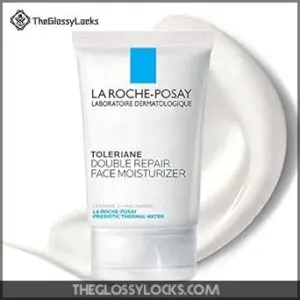
Let’s talk about La Roche-Posay Face Moisturizer Repair—it’s like a soothing hug for your skin.
This lightweight, oil-free formula hydrates for up to 48 hours without clogging pores.
Packed with ceramide-3, niacinamide, and glycerin, it repairs your skin’s barrier and tackles redness while keeping inflammation in check.
It’s fragrance-free and gentle, making it perfect for sensitive, acne-prone skin.
Use it daily after cleansing for soft, balanced skin. Bonus: it absorbs quickly, so no greasy, shiny look—just comfort and results!
Best For: People with sensitive or acne-prone skin looking for a lightweight, hydrating moisturizer that repairs the skin barrier and soothes irritation.
- Lightweight, oil-free formula absorbs quickly without clogging pores.
- Provides up to 48-hour hydration and improves skin barrier function.
- Fragrance-free and gentle, suitable for sensitive and acne-prone skin.
- May not provide enough hydration for very dry skin types.
- Does not contain active acne-fighting ingredients like salicylic acid or benzoyl peroxide.
- Requires consistent use to see long-term skin repair benefits.
2. Tata Harper Clarifying Oily Skin Moisturizer
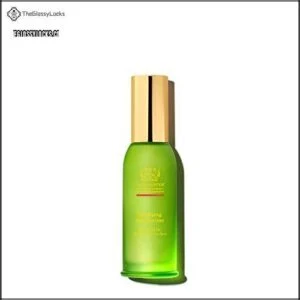
Tata Harper’s Clarifying Oily Skin Moisturizer offers light hydration that won’t leave your skin congested.
If you’re dealing with redness or breakouts, this formula contains salicylic acid from natural sources like white willow bark to gently exfoliate while soothing irritation.
It’s lightweight and perfect under makeup—no greasy residue here.
While some users rave about clearer skin, others find it a bit pricey for the results.
With its botanical ingredients, it’s ideal for acne-prone, sensitive skin seeking balance and smoothness.
Best For: Adults with acne-prone, sensitive skin looking for a lightweight, natural moisturizer.
- Lightweight texture suitable under makeup.
- Contains natural salicylic acid for gentle exfoliation.
- Soothes redness and irritation.
- High price compared to perceived effectiveness.
- Scent may not suit everyone.
- Limited return policy and poor customer service reported.
3. First Aid Beauty Dewy Gel Cream

If your skin craves hydration without the heaviness, First Aid Beauty Dewy Gel Cream might be the perfect pick.
Packed with hyaluronic acid, colloidal oatmeal, and niacinamide, it delivers intense moisture while soothing and improving your skin’s texture.
Its lightweight, non-comedogenic formula guarantees acne-prone skin stays clear and comfortable.
Free from fragrances and harsh chemicals, it’s a safe choice for those with sensitive skin.
Though some notice a slight tackiness, it’s a small trade-off for soft, plump, redness-free skin.
Best For: People with combination or oily, sensitive skin looking for lightweight, hydrating care without clogged pores or irritation.
- Deep hydration with a lightweight, non-greasy texture.
- Safe for sensitive skin with fragrance-free and gentle ingredients.
- Soothes irritation and strengthens the skin barrier.
- Slight tacky residue after application.
- Small jar size may run out quickly with frequent use.
- Some users prefer it as a nighttime product due to its texture.
4. Codex Labs Shaant Balancing Face Cream
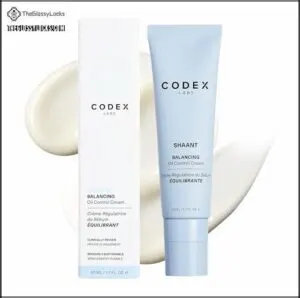
Codex Labs’ innovative Shaant Balancing Face Cream offers a science-backed solution for acne-prone skin.
This lightweight formula contains 1% Bakuchiol (a gentler retinol alternative), Black Jack, and Ashwagandha in its patented ShaantComplex.
It’s clinically proven to reduce sebum by 13% and redness by 5% in just one month.
The microbiome-friendly cream controls oil without over-drying, making it perfect for combination skin.
While some users note an earthy scent and pump dispenser issues, many praise its ability to balance skin, clear pores, and provide a matte finish without clogging pores.
Best For: People with combination or acne-prone skin seeking a lightweight, non-comedogenic cream to reduce oiliness, clear pores, and improve skin texture.
- Reduces sebum production by 13% and redness by 5% in one month.
- Contains 1% Bakuchiol, a gentler retinol alternative suitable for sensitive skin.
- Microbiome-friendly and clinically tested with clean, non-toxic ingredients.
- Pump dispenser is frequently reported as faulty or difficult to use.
- Not as effective for very oily skin types, with some users reporting increased oiliness.
- Earthy scent may not appeal to everyone.
5. Avène Tolerance Control Balm Dry Skin
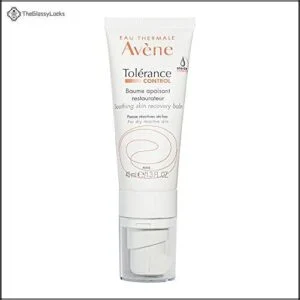
A lifesaver for sensitive, acne-prone skin, Avène Tolerance Control Balm delivers 24-hour hydration while calming irritation in just 30 seconds.
Its sterile, postbiotic-infused formula works wonders for skin affected by tretinoin or rosacea without leaving a greasy residue.
You’ll appreciate how it diffuses redness and improves skin health even in harsh winter conditions.
Though some find the texture thick, it’s worth the extra absorption time before applying makeup.
Pharmacists recommend this French-made balm as one of the most tolerable creams for sensitive skin despite its premium price, making it a great option for those with sensitive skin and acne-prone conditions.
Best For: Those with sensitive, acne-prone, or redness-prone skin, including individuals managing conditions like tretinoin use or rosacea.
- Provides 24-hour hydration and calms irritation in 30 seconds.
- Diffuses redness and restores skin health without greasy residue.
- Suitable for post-laser treatments and allergy or winter-sensitive skin.
- Thick texture requires extra absorption time before makeup.
- May feel less hydrating in extremely dry climates or healing stages.
- Premium price compared to alternative moisturizers.
6. Cetaphil Acne Mattifying Moisturizer Salicylic Acid
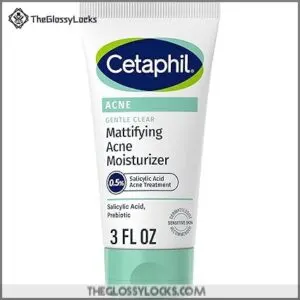
One remarkable feature of Cetaphil Acne Mattifying Moisturizer is its dual-action formula with 0.5% Salicylic Acid.
This lightweight lotion tackles breakouts while providing 48 hours of hydration—perfect for sensitive, acne-prone skin.
You’ll appreciate how it creates a matte finish without feeling heavy under makeup.
The prebiotic complex and botanical ingredients like bisabolol and licorice root work together to soothe redness and improve skin texture.
Users report visible results in just three days, with clearer skin and reduced inflammation.
It’s fragrance-free and non-comedogenic, so your pores can breathe easy.
Many users find that non-comedogenic formulas help prevent pore clogging.
Best For: Individuals with sensitive, acne-prone skin looking for a lightweight, hydrating moisturizer that helps reduce breakouts and redness.
- Provides 48 hours of hydration while controlling acne with 0.5% Salicylic Acid.
- Lightweight, non-greasy formula with a matte finish, suitable under makeup.
- Fragrance-free, hypoallergenic, and dermatologist-recommended for sensitive skin.
- May not fully mattify very oily skin.
- Some users with extremely sensitive skin reported irritation.
- Packaging and texture consistency might vary between batches.
7. Peach Slices Redness Relief Cream
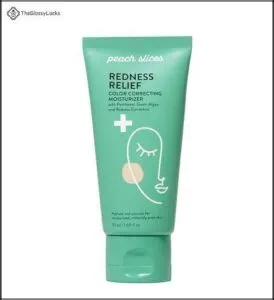
Peach Slices Redness Relief Cream is a go-to for tackling redness while keeping your skin hydrated.
This lightweight moisturizer features calming ingredients like turmeric, panthenol, and cica to soothe irritation.
Its color-correcting technology adjusts for a smooth, even complexion.
Perfect for sensitive skin, it works quickly to visibly reduce inflammation and irritation, while it blends effortlessly, its texture may feel wet at first.
A little goes a long way—just dab it on and let it dry for a peaceful, polished look.
Best For: People with sensitive or redness-prone skin looking for a lightweight, soothing moisturizer that evens out their complexion.
- Instantly reduces redness and calms irritation.
- Lightweight, hydrating formula with clean ingredients.
- Color-correcting technology adjusts for a smooth finish.
- May feel wet initially and wears off after a few hours.
- Not ideal for oily or combination skin types.
- Some users find the texture and scent unpleasant.
8. CeraVe PM Facial Moisturizing Lotion
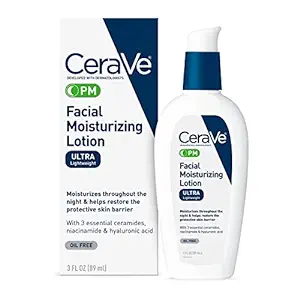
If your skin needs a break from harsh treatments, CeraVe PM Facial Moisturizing Lotion might be your best bet.
Packed with niacinamide to calm redness, hyaluronic acid to lock in moisture, and ceramides to repair your skin barrier, it’s a gentle multitasker.
Being oil-free, fragrance-free, and non-comedogenic means it won’t clog pores or upset sensitive skin.
Its lightweight formula works overnight, leaving skin balanced and hydrated by morning.
Think of it as skincare’s version of a good night’s sleep!
Best For: Individuals with dry, sensitive, oily, or acne-prone skin seeking a lightweight, calming night lotion.
- Calms redness with niacinamide.
- Provides overnight hydration through hyaluronic acid.
- Oil-free, fragrance-free, and non-comedogenic formula suitable for sensitive skin.
- Non-sealed packaging may not appeal to some users.
- May not provide enough moisture for extremely dry skin.
- Requires waiting for other products to absorb before application.
Reducing Acne Redness Naturally
You don’t need fancy products to calm acne redness—simple, natural remedies can do wonders.
Small changes, like icing blemishes or sipping green tea, can help your skin feel and look better.
Applying Ice to Reduce Redness and Swelling
For quick redness relief, ice application works wonders.
Gently press a wrapped ice cube against inflamed skin for 1-2 minutes. This simple ice therapy calms skin, reduces swelling, and shrinks redness by constricting blood vessels.
One benefit is that it can tighten pores effectively.
Repeat this treatment duration up to three times daily, but don’t overdo it—your skin needs breaks. It’s a cooling trick that’s inflammation control made easy, providing quick redness relief!
Anti-inflammatory Diet and Its Benefits
Your diet can secretly fuel acne redness or help calm it down.
Eating anti-inflammatory foods reduces irritation, supporting the gut-skin axis. One might consider products for acne to further assist with redness.
Swap chocolate and sugar for:
- Leafy greens packed with anti-inflammatory compounds.
- Salmon and walnuts for omega-3s to aid inflammation reduction.
- Turmeric-spiced meals for natural redness relief skincare benefits.
Avoid processed snacks—they’re unkind to your skin!
Importance of Gut Health and Prebiotics
The gut microbiome links directly to your overall skin health, including acne treatment.
Feeding it with prebiotics—found in garlic, bananas, and oats—boosts good bacteria, aiding inflammation reduction.
Probiotic benefits extend beyond digestion, subtly calming red, irritated skin.
A healthy dietary impact means fewer flare-ups, so focus on gut-friendly foods to nurture your skin from the inside out, utilizing the concept of prebiotics.
Green Tea and Spearmint Tea for Their Anti-inflammatory Properties
Tea polyphenols and spearmint benefits make these teas acne-fighting heroes. Their anti-inflammatory compounds soothe skin redness and reduce acne-related irritation.
To maximize their power:
- Drink brewed green or spearmint tea daily for redness reduction.
- Try topical application of cooled tea as part of your skin care routine.
- Experiment with brewing methods for stronger anti-inflammatory effects.
Sip smarter, glow better!
Professional Care for Persistent Acne Redness
When redness from acne just won’t budge, it’s time to turn to professional care.
A dermatologist can provide advanced treatments like prescription medications, chemical peels, or laser therapy to tackle stubborn inflammation and restore your skin’s clarity.
Consulting a Dermatologist for Accurate Diagnosis
A dermatologist can help you tackle the confusion of acne vs rosacea, persistent blemishes, and skin redness.
Self-diagnosis often leads to wasted time and money on the wrong acne treatments.
Professional evaluation guarantees the right treatment options for your unique skin care needs.
Don’t guess—trust an expert to manage acne effectively while protecting your skin’s health.
Prescription Treatments Like Isotretinoin and Oral Antibiotics
Prescription medications like isotretinoin and oral antibiotics are game-changers for persistent acne redness.
Isotretinoin offers incredible results but comes with risks like dryness or temporary flares. Oral antibiotics target bacteria, though resistance can develop.
Treatments usually take 2-3 months for noticeable improvement. You might consider alternatives, like hormonal therapies, if side effects arise.
Azelaic acid presents a safe alternative for pregnant individuals. Always consult your dermatologist for a customized acne treatment plan to ensure the best results with minimal side effects.
Advanced Treatments Such as Chemical Peels and Laser Therapy
Chemical peels and laser therapy can work wonders for stubborn acne redness.
Peels remove damaged skin layers, while laser resurfacing reduces redness and targets bacteria.
Combined treatments, like microneedling, boost collagen production and smooth skin.
Many people find at-home peel products effective for managing acne.
| Treatment | Benefits | Healing Time |
|---|---|---|
| Chemical Peels | Reduces scars and hyperpigmentation | 7–10 days |
| Laser Therapy | Minimizes redness, smooths skin | 10–21 days |
| Microneedling | Boosts collagen, smooths texture | 1–2 days |
Importance of Dermatologist Supervision for Optimal Results
Advanced treatments like chemical peels or laser therapy can be lifesavers, but they’re not one-size-fits-all.
A dermatologist’s expert diagnosis guarantees your acne redness gets the right treatment with minimal risks.
They’ll guide you through options while monitoring for scarring prevention and long-term management.
- Personalized care prevents unnecessary irritation.
- Experts minimize procedure risks.
- Supervision confirms redness-reducing acne treatments work best.
- Long-term plans keep redness away.
This approach ensures that you receive personalized care that is tailored to your specific needs, leading to more effective and safer treatments.
Frequently Asked Questions (FAQs)
How to reduce redness & inflammation from acne?
Nearly 85% of people get acne, but calming redness doesn’t have to be tricky.
Try ice packs, niacinamide cream, or anti-inflammatory tea tree oil.
Sunscreen prevents dark spots, while a healthy diet boosts healing!
What is the treatment for redness on the skin?
To treat redness, apply ice to calm inflammation, use a gentle moisturizer with niacinamide, and protect your skin with sunscreen.
Skip harsh products, avoid picking, and try anti-inflammatory ingredients like green tea extract.
How to reduce acne redness overnight?
To calm acne redness overnight, dab ice on the spots to shrink blood vessels.
Apply a thin layer of hydrocortisone or soothing aloe vera gel.
Use a pimple patch for faster healing and less irritation.
Can a dermatologist treat acne redness?
Yes, a dermatologist can help reduce acne redness.
They may recommend treatments like chemical peels, laser therapy, or topical prescriptions to calm inflammation, restore your skin’s balance, and prevent future flare-ups, which can be considered a method to calm inflammation.
What is the best way to treat redness?
Think of redness as your skin’s SOS.
Use gentle cleansers, anti-inflammatory products like niacinamide or azelaic acid, and daily sunscreen.
Ice helps too—it’s like a mini firefighter for angry, inflamed spots!
What is acne redness?
Acne redness happens when inflamed skin triggers blood vessels to dilate, creating a flushed look.
It’s your body’s way of healing, but prolonged redness can leave dark spots or scars if not managed properly.
How long does acne redness typically last?
Redness is like an uninvited guest—it lingers longer than you’d like.
It typically fades in 6-12 weeks, depending on severity.
Consistent care, sunscreen, and anti-inflammatory products can help speed up the healing process.
What ingredients calm acne-related irritation effectively?
Look for soothing ingredients like niacinamide, aloe vera, azelaic acid, or green tea extract.
These help calm inflammation, reduce redness, and repair your skin barrier, leaving your skin happier and less irritated over time, which can be achieved with ingredients like aloe vera.
Does stress contribute to persistent acne redness?
Studies show stress can increase acne flare-ups by up to 23%.
When you’re stressed, your body pumps out cortisol, triggering oil production and inflammation.
So, next time life feels hectic, remember, a little self-care helps!
Are there over-the-counter redness-reducing spot treatments?
You’ll find over-the-counter spot treatments like La Roche-Posay Effaclar Duo or Mario Badescu Drying Lotion helpful.
They target redness with anti-inflammatory ingredients, like niacinamide or salicylic acid, and work overnight to calm irritated skin, utilizing anti-inflammatory properties.
Conclusion
Banishing acne redness might feel like taming a wildfire, but with the right acne treatment that reduces redness, you’ve got this.
Stick to proven ingredients like salicylic acid and niacinamide, and don’t forget soothing moisturizers to hydrate without clogging pores.
Avoid picking—it’s a trap that worsens irritation.
Natural remedies like ice or green tea can help, but professional therapies are game-changers for stubborn cases.
A consistent routine, not quick fixes, makes all the difference.
- https://www.sciencedirect.com/science/article/abs/pii/S0378517320301216?casa_token=_0VqLG2DFxoAAAAA:7t9TP8CRxQAqd173lE8rW6WjPajcDXEqlN-yYbQpahTHKFuLHMUsXelvhLNyI7GmU0U44_OO1w
- https://www.ncbi.nlm.nih.gov/pmc/articles/PMC4554394/
- https://www.aad.org/public/diseases/rosacea/treatment/acne-like
- https://www.instagram.com/sirdermzalot/?hl=en
- https://www.goodrx.com/isotretinoin?rvo_aff=1&rvo_brandid=GoodRx&rvo_prodid=2545fe51-8f98-4e39-b5f3-d03cd3894005&rvo_subid=2545fe51-8f98-4e39-b5f3-d03cd3894005&rvo_subid2=%2Fhealth%2Fskin%2Fwp-3879107&correlationId=null

